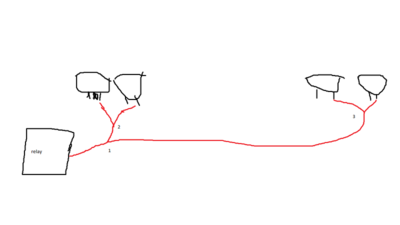sometimes I read post and is funny all contradictions around. I can understand ppl saying closer the relay to the headlights less lost on the wire distance, I can understand everything like that but, look, If is mandatory to put the relays close to the headlights to prevent loosing, then never put your battery on the trunk, because the worst device to suck load is the starter motor ( 100-120 amps to crank, maybe more if a high compression engine ). You can put a 0 gauge wire to feed it from 15 feet, but still will be loosing on the wire distance. This becomes worst to feed back 20, 30 or 50 amps to charge back the battery, specially when the wire coming out from alt it uses to be no more than 8 gauge, maybe 6 ? some ppl still keep the stock 12 gauge wire!
I will only share my own experience. I have run my relays at a side of the batt in the past, with forward lighting harness cut and getting relays spliced in the line and at this moment I'm running my relays hidden down the kick panel, with no cut wires, just relocating floor dimmer switch terminals into the 87 terminal relay, and adding a piece of wire, same color, to trigger it at 86 terminal coming from floor switch. Guess what ? NO DIFFERENCE on intensity, no dimming lights no nothing againts put the relays closer to the headlights. We are talking about maybe 10 maybe 12 amps tops ( depending on voltage ) when 4 high beams are on ? the stock 14 gauge wire on 9-10 or maybe 15 feet wire talking about the far right side headlight and the regular packard 56 terminals are PLENTY for these 10-12 amps. Anyway, I barelly use high beams because the low beams using the halogen sealed beams is PLENTY.
Of course I'm running a parallel wiring path from my 78 amps alternator up to ammeter, and the terminal 30 relays are being feeded straight from it. Once again, NO DIFERENCE on light intensity and no dimming lights. Sure every upgrade must be accomplished to source it, and all the electrical system must be mantenienced. The dimming light deal will be worst if the alt is not able to feed the upgrade, no matter where you put the relays.
I won't say it must be made like this, I'm just sharing my experience. I wanted to keep a stock look on my engine bay with no visible relays and I rebuit my lighting harness. The ground for the headlights is being taken from the radiator core support like originally is ( the harness is MADE in that way ), and the ground for the relays to 85 terminal on back of kick panel is being taken from the floor dimmer switch screws. My relays are safe from dust, rust, oil, heat... and no visible.
Oh and as mentioned, I'm running regular halogen sealed beams. My only concern about them is the heat to the headlight fillers, just that.
Sure there is less load sucker headlights, but well I wished a full stock look everywhere, even into the headlight glass, being still sealed beams


 update report.
update report. i used the red & violet wires as the switch and ran new power wire going to the lights.
i used the red & violet wires as the switch and ran new power wire going to the lights.
















